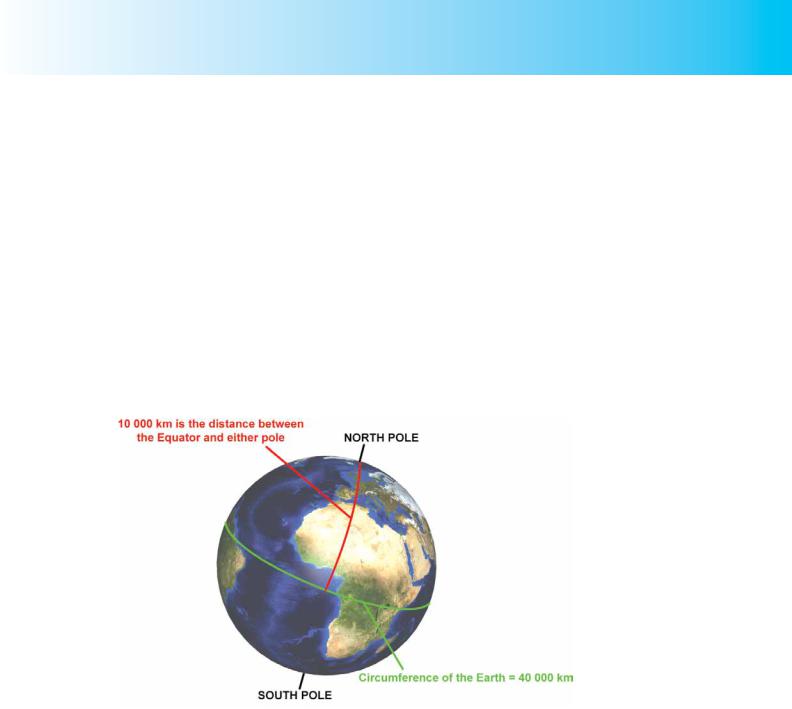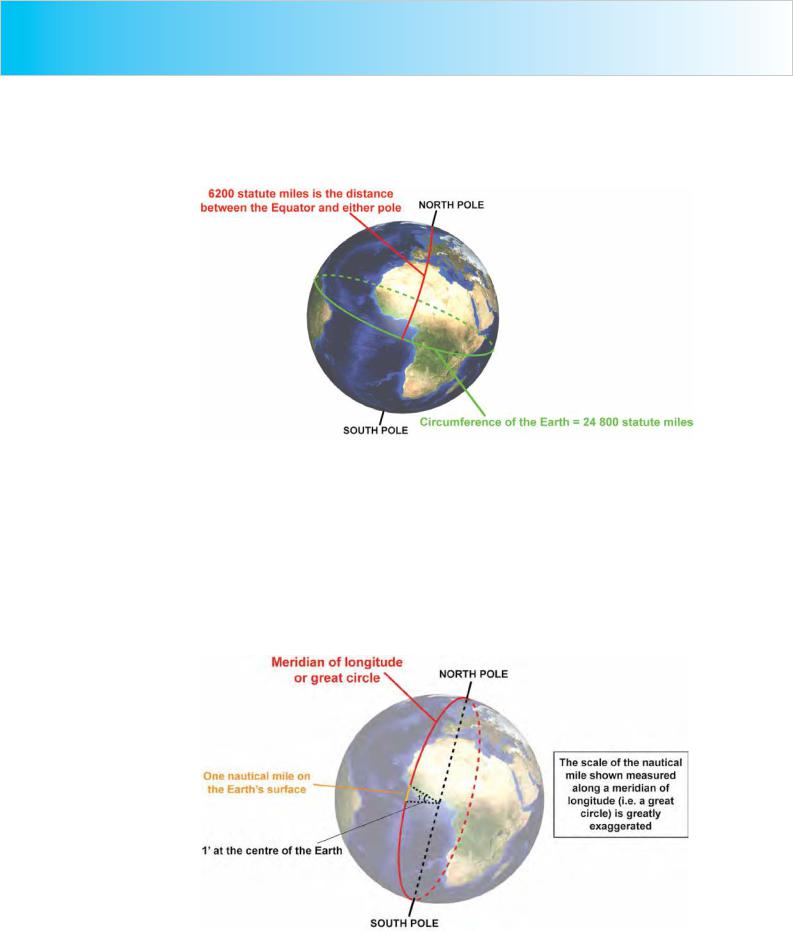
ppl_03_e2
.pdf
ID: 3658
Customer: Oleg Ostapenko E-mail: ostapenko2002@yahoo.com
Customer: Oleg Ostapenko E-mail: ostapenko2002@yahoo.com
CHAPTER 4: SPEED, DISTANCE AND TIME
If distances are given in kilometres, the formula groundpeed = distance / time will give kilometres per hour or kilometres per minute, or per second.
If distance is given in nautical miles, the most common unit of distance in aviation, the formula groundspeed = distance / time will give nautical miles per hour or nautical miles per minute, or per second.
Note that nautical miles per hour are called knots. For example, an airspeed or groundspeed of 100 nautical miles per hour is referred to as 100 knots.
DISTANCE.
If a given groundspeed is maintained by an aircraft for a given time, a resulting distance will be covered in that time.
distance = groundspeed × time
A groundspeed of 160 miles per hour maintained for 2 hours will, according to the above formula, result in a distance of 320 miles being covered.
distance = groundspeed × time = 160 miles per hour × 2 hours = 320 miles
But, what distance would be covered if 160 miles per hour were maintained for 30 minutes? This is where units become crucial. In the formula distance = groundspeed × time, if the speed is in miles per hour, then in order to get a sensible answer for distance, the time must be in hours. We could not, for instance, get a sensible answer if we calculate as follows.
distance = groundspeed × time = 160 miles per hour × 30 minutes = ???
For the distance to be in miles, the time must be in hours. A simple expression of unit analysis illustrates why.
distance = groundspeed × time = 160 miles per hours × 2 hours = 320 miles
distance = hoursmiles × hours = miles
The most
common unit of speed in
aviation is
the knot. 100 knots is 100 nautical miles per hour.
The
distance covered
along track
= groundspeed × time.
The second equation above, in which only the units are shown, is the unit analysis equation. You can see that the hours cancel out, leaving miles as the unit of the answer.
As shown below, unit analysis does not work out if we consider 160 miles per hour for 30 minutes.
distance = hoursmiles × minutes = ???
So, to return to our problem of how much distance is covered in 30 minutes by an aircraft whose groundspeed is 160 miles per hour, we must convert the minutes into hours by dividing by 60. We may now write:
57

Order: 6026
Customer: Oleg Ostapenko E-mail: ostapenko2002@yahoo.com
Customer: Oleg Ostapenko E-mail: ostapenko2002@yahoo.com
CHAPTER 4: SPEED, DISTANCE AND TIME
1 80
distance = groundspeed × time = 160 × 30 = 160 × 1 = 80 miles 60 2
2 1
This is an answer that appears sensible.
Nautical Miles and Knots.
So how much distance would an aircraft with a groundspeed of 90 knots cover in 2 hours? 90 knots, remember, is 90 nautical miles per hour. Here is the equation.
distance = groundspeed × time = 90 × 2 = 180 nautical miles
And how far would the same aircraft travel in 20 minutes? Remember, if we want the distance in nautical miles, because the speed is in knots (i.e. nautical miles per hour) we must convert minutes into hours, by dividing by 60.
Thus,
1 |
30 |
|
|
distance = speed × time = 90 × 20 |
= 90 × 1 = 30 nautical miles |
||
60 |
|
3 |
|
3 |
1 |
|
|
TIME.
The time taken for
an aircraft to cover a given distance along track
= distance groundspeed
The time taken for an aircraft to cover a given distance along track is given by the equation:
time = |
distance |
groundspeed |
How long does it take an aircraft travelling at an average groundspeed of 70 miles per hour to cover 210 miles? Examining the units, we may deduce that, if speed is in miles per hour and distance is in miles, the time taken will be in hours.
|
|
|
3 |
|
|
time = |
distance |
= |
|
210 miles |
= 3 hours |
groundspeed |
|
70 miles per hour |
|||
|
|
|
1 |
|
|
The following analysis of units shows that we may reasonably expect an answer in hours.
So: |
distance |
|
miles |
|
hour |
|
|
time = |
= |
= miles × |
= hour |
||||
miles |
miles |
||||||
|
speed |
|
|
|
|||
|
|
|
hour |
|
|
|
(Mathematics teaches us that dividing by a fraction is the same as multiplying by the inverse of that fraction.)
But, what if we needed to have the answer in minutes? How many minutes would it take for an aircraft whose groundspeed is 120 miles an hour to cover 30 miles? As before, we must make the units match one another. If we want the time in minutes, and all distances are in miles, then speed must be in miles per minute.
58

ID: 3658
Customer: Oleg Ostapenko E-mail: ostapenko2002@yahoo.com
Customer: Oleg Ostapenko E-mail: ostapenko2002@yahoo.com
CHAPTER 4: SPEED, DISTANCE AND TIME
|
|
|
2 |
|
|
120 miles per hour = |
120 = 2 miles per minute |
||||
|
|
|
60 |
|
|
|
|
|
1 |
15 |
|
|
|
|
|
|
|
time = |
distance |
= |
30 miles |
= 15 minutes |
|
groundspeed |
|
2 miles per minute |
|||
|
|
|
|
1 |
|
Of course, we could have kept the original figures, obtained a time in hours and then converted that answer to minutes by multiplying by 60.
|
|
|
1 |
|
|
|
|
distance |
30 |
|
1 |
|
|
time = |
|
= |
|
= |
|
hour |
groundspeed |
120 |
4 |
||||
|
|
|
4 |
|
|
|
14 hour × 60 = 15 minutes
We may use any system of calculation which suits us, as long as we think about units, and make sure that they match.
Some Examples.
Let us do a couple more examples.
How many seconds does it take a car travelling at an average speed of 120 kilometres an hour to cover 100 metres?
distance time = speed
Firstly, we must think about the units that we are using.
Distance is in metres, speed is in kilometres per hour, and we want the time in seconds.
Let us, therefore, convert speed into metres per second. We can do that in three steps:
1. 160 kilometres per hour = 120 × 1 000 = 120 000 metres per hour.
2. |
160 000 metres per hour = 120 000 meters per minute = 2 000 metres |
||||
|
|
60 |
|
per minute. |
|
|
|
|
|
|
|
3. |
2 000 metres per minute = |
2 000 |
metres per second = 33.33 metres |
||
|
|||||
|
|
60 |
|
per second. |
|
|
|
|
|
|
|
Now, applying the equation |
time = |
distance |
we get: |
||
|
|
|
|
speed |
|
time = 33.33100 metres per second = 3 seconds, approximately.
59

Order: 6026
Customer: Oleg Ostapenko E-mail: ostapenko2002@yahoo.com
Customer: Oleg Ostapenko E-mail: ostapenko2002@yahoo.com
CHAPTER 4: SPEED, DISTANCE AND TIME
When carrying out
calculations with
speed, distance and time, make sure that the units match one another.
Let us work out one final problem.
An aircraft has a groundspeed of 100 knots; how long will it take the aircraft to cover 20 nautical miles?
Obviously, the time taken is going to be less than an hour, so it would be reasonable to express the answer in minutes. In the equation, then, we might consider converting 100 knots (that is, 100 nautical miles per hour) to nautical miles per minute, by dividing that term by 60.
|
|
|
|
1 |
|
|
12 |
|
|
distance |
|
20 |
60 |
|
60 |
|
|
time (minutes) = |
|
= |
|
= 20 × |
|
= |
5 |
= 12 minutes |
groundspeed |
100 |
100 |
||||||
|
|
|
60 |
5 |
|
1 |
|
|
Never forget that navigation calculations require that we continually bear in mind the importance of units, when carrying out speed, distance, time calculations.
As long as you remain aware of the importance of matching the units to one another, you should have no difficulty in carrying out speed, distance, time calculations using the navigation computer. (See Chapter 11 and enclosed CD-ROM.)
The Navigation Computer. See Chapter 11 and the accompanying CD-ROM.
You should also practise rounding distance, speed and time figures up or down to convenient whole numbers, so that you can carry out calculations mentally, in order to be able to calculate revised groundspeeds and update ETAs during in-flight navigation. Also check mentally that your results are reasonable (a ‘gross error check’).
60

ID: 3658
Customer: Oleg Ostapenko E-mail: ostapenko2002@yahoo.com
Customer: Oleg Ostapenko E-mail: ostapenko2002@yahoo.com
CHAPTER 4: SPEED, DISTANCE AND TIME
THE PRINCIPAL UNITS OF DISTANCE.
The principal units of distance in aviation are the nautical mile, the statute mile and the kilometre. The nautical mile is by far the most widely-used unit of distance because of its direct relationship to degrees of latitude; but the Federation Aéronautique Internationale, which keeps and awards records of distance and speed in aviation, and which regulates badge awards in the sport of gliding, uses the kilometre as the standard distance.
Kilometre.
The kilometre, which is 1 000 metres, is naturally based on the smaller unit, the metre. The metre was historically defined by the French Academy of Sciences, in 1791, as being 1 / 10 000 000 of the quadrant of the Earth’s circumference running from the North Pole, through Paris, to the Equator. That definition makes the distance from the North Pole to the Equator, through Paris, 10 000 kilometres. The metre is now defined as equal to 1 650 763.73 wave lengths of the orange-red line in the spectrum of the Krypton-86 atom, under specified conditions.
Figure 4.2 The kilometre.
The kilometre is used as the standard unit of distance throughout most of the world, except in Britain and the United States. In professional aviation, however, the standard unit of distance is the nautical mile.
Statute Mile.
The original mile was based on the Roman measure of “mille passus” which means “a thousand paces”. This first mile measured 4 840 feet. During the reign of Queen Elizabeth I, in 1593, the mile was re-defined by royal statute (hence the name statute mile) to be 8 furlongs of 660 feet each, making the mile equal to 5 280 feet; this is its present definition.
The mile is the standard unit for measuring road distances in Britain and the United States of America, but it is now little used in aviation. However, some older light aircraft, e.g. Tiger Moth, have ASIs calibrated in MPH, which can have a significant effect if a navigation exercise has been planned in knots without allowance for conversion of units.
61

Order: 6026
Customer: Oleg Ostapenko E-mail: ostapenko2002@yahoo.com
Customer: Oleg Ostapenko E-mail: ostapenko2002@yahoo.com
CHAPTER 4: SPEED, DISTANCE AND TIME
The average distance from the Equator to either pole is 6 200 statute miles. The circumference of the Earth is 24 800 statute miles.
Figure 4.3 The Statute Mile.
Nautical Mile.
The nautical mile is the most commonly used, large-scale measure of distance in aviation.
The nautical mile is the length on the Earth’s surface, measured along a great circle, of an arc subtended by an angle of one minute at the centre of the Earth. Therefore, one degree of latitude is sixty nautical miles on the Earth’s surface. Because of its direct relationship with latitude, the nautical mile has been the standard unit of distance for seafarers for several hundred years. One nautical mile is also defined as 1 852 metres or 6 080 feet.
Figure 4.4 The Nautical Mile is the length on the surface of the Earth, measured along a great circle, of an arc subtended by an angle of one minute at the centre of the Earth. (Scale is greatly exaggerated.)
62

ID: 3658
Customer: Oleg Ostapenko E-mail: ostapenko2002@yahoo.com
Customer: Oleg Ostapenko E-mail: ostapenko2002@yahoo.com
CHAPTER 4: SPEED, DISTANCE AND TIME
The nautical mile and the knot (the nautical mile per hour) are used almost exclusively throughout the world of professional aviation and in marine transport.
IMPERIAL AND METRIC UNITS.
The smaller distances in current use in aviation are also a mixture of metric units and the older imperial units. Imperial units have evolved from English units of measure.
The standard unit of measure of altitude is the foot, the system of Flight Levels being based on altitude in feet measured from a pressure datum of 1013.2 hectopascals (millibars). Conversely, visibility is measured in metres and kilometres. Runway lengths are given in metres.
Figure 4.5 is a table showing the principal conversion factors which are used when converting between imperial and metric units and vice versa. You should note, however, that most of these conversions can be made with sufficient accuracy using the navigation computer (See Chapter 11).
Conversion Table for Units of Distance
1 statute mile |
1.61 kilometres (km) |
0.87 nautical miles |
5 280 feet |
1 nautical mile |
1.85 km |
1.15 statute miles |
6 080 feet |
1 kilometre |
0.54 nautical miles |
0.62 statute miles |
3280 feet |
1 metre |
3.28 feet |
|
|
1 foot |
0.3048 metres |
|
|
1 inch |
2.54 centimetres |
|
|
1 yard |
3 feet |
|
|
Figure 4.5 Conversion Table for Units of Distance.
63

Order: 6026
Customer: Oleg Ostapenko E-mail: ostapenko2002@yahoo.com
Customer: Oleg Ostapenko E-mail: ostapenko2002@yahoo.com
CHAPTER 4: SPEED, DISTANCE AND TIME QUESTIONS
Representative PPL - type questions to test your theoretical knowledge of Speed, Distance and Time.
1.Which of the following is the correct practical definition of a kilometre?
a.It is 1/15 000th of the average distance on the Earth between the equator and either pole
b.It is 1/20 000th of the average distance on the Earth between the equator and either pole
c.It is 1/10 000th of the average distance on the Earth between the equator and either pole
d.It is 1/000th of the average distance on the Earth between the equator and either pole
2.Approximately how long would an aircraft whose groundspeed was 100 knots take to fly 100 kilometres?
a.Approximately 1 hour
b.Approximately 33 minutes
c.Approximately 45 minutes
d.Approximately 100 minutes
3.If the groundspeed of an aircraft is 90 knots, how far will it fly in 20 minutes?
a.1800 nautical miles
b.4½ nautical miles
c.30 nautical miles
d.45 nautical miles
4.What is the definition of a nautical mile?
a.The nautical mile is the length on the Earth’s surface, measured along a great circle, of an arc subtended by an angle of one degree at the centre of the Earth
b.The nautical mile is the length on the Earth’s surface, measured along a great circle, of an arc subtended by an angle of one minute at the centre of the Earth
c.The nautical mile is the length on the Earth’s surface, measured along any line of latitude, of an arc subtended by an angle of one minute at the centre of the Earth
d.The nautical mile is the length on the Earth’s surface, measured along a great circle, of an arc subtended by an angle of one second at the centre of the Earth
5.What is the groundspeed of an aircraft which has taken 10 minutes to cover 20 nautical miles?
a.200 nautical miles per hour
b.200 kilometres per hour
c.180 knots
d.120 knots
64

ID: 3658
Customer: Oleg Ostapenko E-mail: ostapenko2002@yahoo.com
Customer: Oleg Ostapenko E-mail: ostapenko2002@yahoo.com
CHAPTER 4: SPEED, DISTANCE AND TIME QUESTIONS
6.How long would it take for an aircraft whose groundspeed was 80 knots to cover 20 nautical miles?
a.4 minutes
b.15 minutes
c.20 minutes
d.4 hours
7.What distance would an aircraft travelling at a groundspeed of 116 knots cover in 45 minutes?
a.87 nautical miles
b.Approximately 2½ nautical miles
c.116 nautical miles
d.75 nautical miles
8.The distance of the first leg of a cross country flight is 40 nautical miles.
Your calculated groundspeed is 100 knots. How long should it take you to complete the leg?
a.About 2½ hours
b.About 15 minutes
c.24 minutes
d.About 40 minutes
Question |
1 |
2 |
3 |
4 |
5 |
6 |
7 |
8 |
Answer |
|
|
|
|
|
|
|
|
The answers to these questions can be found at the end of this book.
65
Customer: Oleg Ostapenko E-mail: ostapenko2002@yahoo.com
66
